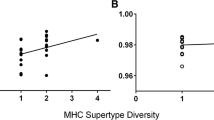Abstract
The chemosensory identity of mice and rats is determined partly by polymorphic genes of the major histocompatibility complex (MHC). In inbred strains of mice, as well as in seminatural populations, MHC‐associated mating preferences selectively influence reproductive success, thus serving to promote heterozygocity in the MHC. In order to determine whether MHC‐associated chemosignals are present in humans, two studies were conducted. In a first study, olfactory identification of MHC‐associated chemosignals was conducted on 12 trained rats' responses to the urine odors of humans. In a second study, MHC‐associated olfactory cues in humans were analyzed by means of gas chromatography. The results indicate that the urine odors of humans are associated with the MHC and demonstrate that the profile of volatile components in the urine odors shows some association with the MHC. Furthermore, results show that a profile of some specific components, as well as a few ubiquitous volatiles, constitutes MHC‐associated odor signals in humans.
Similar content being viewed by others
References
Beauchamp, G.K., K. Yamazaki, J. Bard & E.A. Boyse, 1988. Preweaning experience in the control of mating preferences by genes in the major histocompatibility complex of the mouse. Behav. Genet. 18: 537-547.
Bestmann, H.J., K. Haberkorn, O. Vostrowsky, F. Eggert & R. Ferstl, 1994. Chemical analysis of urinary chemosignals in humans. Adv. Biosci. 93: 529-534.
Boland, W., P. Ney, L. Jänicke & G. Gassmann, 1984. Analysis of Volatiles. De Gruyter, Berlin.
Boyse, E.A., G.K. Beauchamp, J. Bard & K. Yamazaki, 1991. Behavior and the major histocompatibility complex of the mouse, pp. 831-846 in Psychoneuroimmunology, 2nd edn., edited by R. Ader, D.L. Felten and N. Cohen. Academic Press, San Diego.
Boyse, E.A., G.K. Beauchamp, K. Yamazaki, & J. Bard, 1990. Genetic components of kin recognition in mammals. pp. 148- 161 in Kin Recognition, edited by P.G. Hepper, Cambridge University Press, London.
Brown, J.L. & A. Eklund, 1994. Kin recognition and the major histocompatibility complex: An integrative review. American Naturalist 143: 435-461.
Brown, R.E., P.B. Singh, & B. Roser, 1987. The major histocompatibility complex and the chemosensory recognition of individuality in rats. Physiol. Behav. 40: 65-73.
Bruce, H., 1959. An exteroceptive block to pregnancy in the mouse. Nature 184: 105.
Bruce, H., 1960. A block to pregnancy in the mouse caused by proximity of strange males. J. Reproduct. Fertility 1: 96-103.
Duncan, H.J., G.K. Beauchamp, & K. Yamazaki, 1992. Assessing odor generalization in the rat: A sensitive technique. Physiol. Behav. 52: 617-620.
Eggert, F., C. Höller, D. Luszyk, W. Müller-Ruchholtz & R. Ferstl, 1997. MHC-associated and MHC-independent urinary chemosignals in mice. Physiol. Behav. 61: 957-961.
Eggert, F., B. Wobst, N. Zavazava, W. Müller-Ruchholtz & R. Ferstl, 1994. Psychobiology of the immune system: Behavioral factors in the maintenance of immunogenetical variability. Psychologische Beiträge. 36: 152-157.
Ferstl, R., F. Eggert, E. Westphal, N. Zavazava, & W. Müller-Ruchholtz, 1992. MHC-related odors in humans, pp. 205-211 in Chemical Signals in Vertebrates VI, edited by R.L. Doty and D. Müller-Schwarze. Plenum, New York.
Giphart, M.J. & J. D'Amaro, 1983. HLA and reproduction? J. Immunogen. 10: 25-29.
Manning, C.J., E.K. Wakeland & W. K. Potts, 1992. Communal nesting patterns in mice implicate MHC genes in kin recognition. Nature 360: 581-583.
McCormick, J.P., B.A. Sommerville, F. Eggert, B. Wobst & D.M. Broom, 1994. Gas chromatography and pattern matching of headspace samples from human sweat. Adv. Biosci. 93: 539-542.
Nordlander, C., L. Hammarström, B. Lindblom & C.I.E.E. Smith, 1983. No role of HLA in mate selection. Immunogenetics 18: 429-431.
Pollack, M.S., C.J. Wysocki, G.K. Beauchamp, D. Braun, C. Callaway & B. Dupont, 1982. Absence of HLA association or linkage for variations in sensitivity to the odor of androstenone. Immunogenetics 15: 579-589.
Porter, R.H., 1991. Human reproduction and the mother-infant relationship: The role of odors, pp. 429-442 in Smell and Taste in Health and Disease, edited by T.V. Getchell, L.M. Bartoshuk, R.L. Doty and J.B. Snow. Raven, New York.
Porter, R.H., J.M. Cernoch & F.J. McLaughlin, 1983. Maternal recognition of neonates through olfactory cues. Physiol. Behav. 30: 151-154.
Porter, R.H. & J.D. Moore, 1981. Human kin recognition by olfactory cues. Physiol. Behav. 27: 493-495.
Potts, W.K., C.J. Manning & E.K. Wakeland, 1991. Mating patterns in seminatural populations of mice influenced by MHC genotype. Nature 352: 619-621.
Potts, W.K. & E.K. Wakeland, 1990. Evolution of diversity at the major histocompatibility complex. Trends. Ecol. Evol. 5: 181-187.
Potts, W.K. & E.K. Wakeland, 1993. Evolution of MHC genetic diversity: A tale of incest, pestilence and sexual preference. Trends Genet. 9: 181-187.
Rosenberg, L.T., D. Cooperman & R. Payne, 1983. HLA and mate selection. Immunogenetics 17: 89-93.
Roser, B., R.E. Brown & P.B. Singh, 1991. Excretion of transplantation antigens as signals of genetic individuality, pp. 187-209 in Chemical Senses, Vol. 3: Genetics of Perception and Communications, edited by C.J. Wysocki and M.R. Kare. Marcel Dekker, New York.
Schwende, F.J., J.W. Jorgenson & M. Novotny, 1984. Possible chemical basis for histocompatibility-related mating preference in mice. J. Chem. Ecol. 10: 1603-1615.
Sommerville, B.A., B. Wobst, J.P. McCormick, F. Eggert, N. Zavazava & D.M. Broom, 1994. Volatile identity signals in human axillary sweat: The possible influence of MHC class I genes. Adv. Biosci. 93: 535-538.
Yamazaki, K., G.K. Beauchamp, J. Bard, E.A. Boyse, & L. Thomas, 1991. Chemosensory identity and immune function in mice, pp. 211-225 in Chemical Senses, Vol. 3: Genetics of Perception and Communications, edited by C.J. Wysocki and M.R. Kare. Marcel Dekker, New York.
Yamazaki, K., G.K. Beauchamp, D. Kupniewski, J. Bard, L. Thomas & E.A. Boyse, 1988. Familial imprinting determines H-2 selective mating preferences. Science 240: 1331-1332.
Yamazaki, K., G.K. Beauchamp, C.J. Wysocki, J. Bard, L. Thomas & E.A. Boyse, 1983. Recognition of H-2 types in relation to the blocking of pregnancy in mice. Science 221: 186-188.
Author information
Authors and Affiliations
Rights and permissions
About this article
Cite this article
Eggert, F., Luszyk, D., Haberkorn, K. et al. The major histocompatibility complex and the chemosensory signalling of individuality in humans. Genetica 104, 265–273 (1998). https://doi.org/10.1023/A:1026431303879
Issue Date:
DOI: https://doi.org/10.1023/A:1026431303879




